What are the best sales channels for online selling?
The best eCommerce sales channels include setting up a website, social media platforms, and online marketplaces. Instead of relying on a single sales channel, use a combination of channels and tactics to reach potential customers. The right channel mix depends on your products and target market.
Introduction
These days, there are just so many ways to shop online.
You might discover a product on social media, research it on Google, and then check prices and reviews on platforms like Amazon before making a purchase decision.
These days, the possibilities are endless!
Choosing where to sell online can be as crucial as what you’re selling.
The right platform can put your products in front of the right audience, leading to more sales and growth. Choose the wrong channel, and you’ll struggle to gain any traction.
But with so many options, how do you make the right choice?
That’s what we’re going to explore in this guide.
We’ll dive deep into eCommerce sales channels. You’ll discover your options and learn the advantages of each channel. We’ll also uncover real-life examples of businesses that have excelled with the right sales channel strategy.
Let’s dive in.
Why choosing the right sales channels matters
Imagine you’re selling lemonade. Would you set up your stand in a desert where no one walks by or in a park on a hot day?
Picking the right online sales channel is like finding that busy park.
So, just like you wouldn’t put your lemonade stand in the middle of nowhere, don’t put your online shop somewhere no one’s looking.
Let’s break it down.
Impact on reach and customer engagement
Picking the right sales channel helps you get your product in front of the right audience. We’re not just talking about reaching as many people as possible.
It’s about targeting the shoppers most likely to be interested in your products. For example, if you sell unique craft items, Etsy would allow you to reach a more targeted audience than a general platform like eBay. You want to sell your products where your target audience spends their time online.
Maximizing sales opportunities
Some platforms and sales channels have an existing connection with customers. Shoppers associate some platforms with quality, security, or convenience. By selling on these channels, customers are more likely to trust you and make a purchase.
For example, 89% of online shoppers prefer to buy products from Amazon than other eCommerce sites:
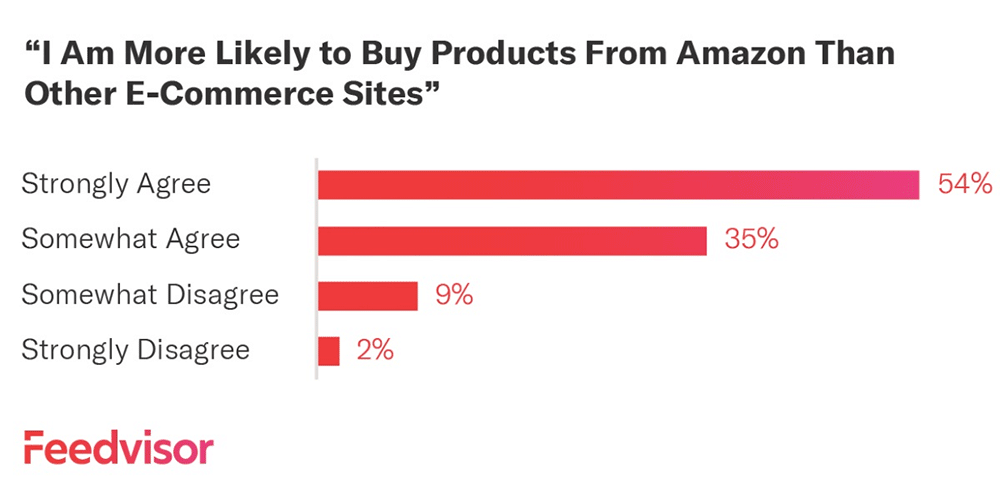
Resource optimization and ROI
When you sell on a platform perfect for your products, you spend less time and money trying to attract customers. Your ideal customers are already there, looking for your products. So, you don’t have to spend money on ads or invest time getting your customers to come to you.
9 best eCommerce sales channels
So, what are the different ways you can reach your end customers?
Well, there are plenty of options.
This HubSpot study of eCommerce stores gives a breakdown of the most common sales channels:
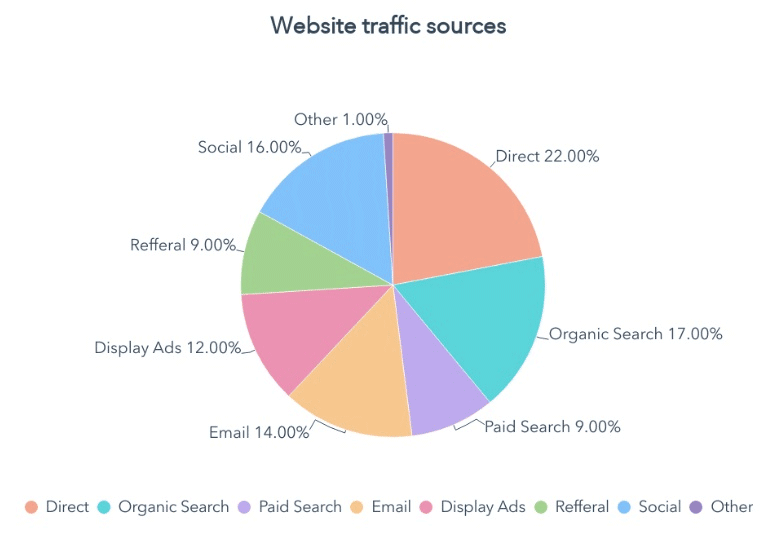
It’s a helpful look at the most common retail sales channels for eCommerce. But it doesn’t account for third-party marketplaces, social commerce, and others.
Let’s take a closer look at your options.
If you’re new to online selling, you should check out the resources below. You’ll learn everything you need to know about building an online business.
1. eCommerce platforms
eCommerce platforms let you set up your own online store. The big plus of having your own store is that you’re in control. You decide everything about how it looks and runs.
But you also need to work a bit harder to attract customers. Nobody knows about your store when you’re just starting out, so you’ll have to invest in marketing to build awareness and drive traffic.
There are a bunch of platforms out there. Some are easy to use and are great for beginners. Others have more features that larger businesses will find useful.

Shopify is one that many people know. It makes it simple to set up a store, even if you’re not very tech-savvy. They give you tools to add products, set prices, and handle payments.
WooCommerce is different because it works with WordPress. It’s a bit more technical, but it’s free and offers almost unlimited customization options.
BigCommerce is also a top choice for many. It allows you to integrate your marketplace and social commerce sales seamlessly. Many big brands use BigCommerce for their online shops.
The right platform depends on what you need and how comfortable you are with web development.
If you need some help choosing a platform and building your store, we’ve got you covered. Our walkthrough guide shows you how to build a store in manageable steps.
2. Online marketplaces
These platforms host products from multiple sellers and attract a vast audience. Instead of having your own separate store, you have a storefront within a bigger site.
One of the great things about online marketplaces is that they already have a lot of shoppers. This means you have a good chance of getting your products in front of lots of people without doing extra work to attract customers.
But there’s a trade-off. Since it’s not your own personal store, you don’t have complete control over how everything looks. And the marketplace will take a percentage from your sales since they’re helping you reach customers.
There are plenty of online marketplaces out there, but a few stand out.

Amazon is the biggest name in eCommerce. You can find almost anything there, from electronics and toys to clothes and food. There’s a huge audience of potential customers you can reach, but the competition is fierce.
eBay is another huge name in eCommerce. It’s known for used items and collectibles, but you can also sell new products. eBay shoppers are generally more budget-conscious than Amazon buyers.
Etsy is the go-to place for handmade, vintage, and unique items. It’s a good choice if you make crafts and art or sell unique and vintage items.
Choosing the right online marketplace depends on what you’re offering and who you want to reach. Looking to expand beyond eBay and Amazon? Check out the resources below to discover the best marketplaces to sell online.
3. Social media platforms
Social media platforms aren’t just for sharing vacation photos. They’ve become vital new sales channels for eCommerce businesses.
The great thing about selling on social media is that it’s where many people spend a lot of their time. You can reach your audience where they already are. Instead of hoping they find you, you’re setting up shop right where they hang out online.
Many of these platforms have added social commerce integrations to make it easier for businesses to get direct sales. Social commerce is a big trend in eCommerce.
Value of social commerce sales worldwide from 2022 to 2026:
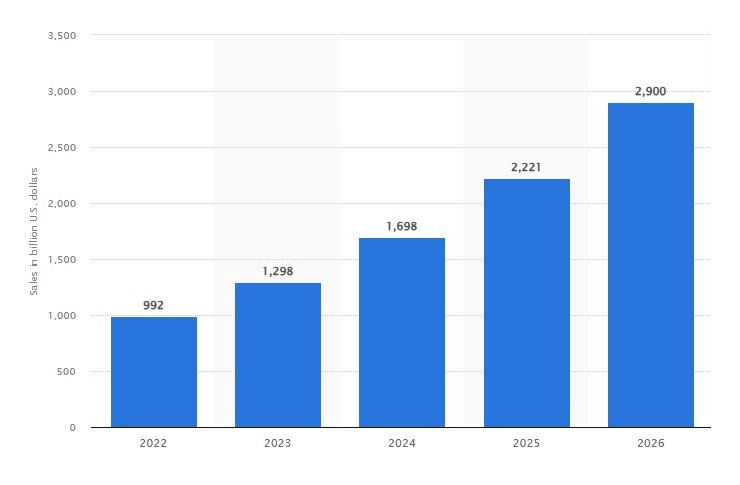
Sites like Instagram and Pinterest allow you to add “shop now” or “buy” buttons directly to your posts. You can also tag products in photos or videos. When someone taps on the tag, they’ll get more information about the product details and can buy without having to leave the platform.
Keep in mind that each social media platform has a unique audience. For example, younger users have recently flocked to TikTok and Snapchat. It’s important to know where your customers are hanging out and show your products there.
4. Search engine marketing (SEM)
Have you ever typed something into Google and noticed a bunch of product photos at the top with the word “Promoted” next to them?
That’s an example of search engine marketing (SEM).

SEM lets you pay to get your products featured at the top of the search engine results page.
Why is this helpful?
Well, people use search engines to research and buy products.
Leading price comparison portals ranked by brand awareness in the United States in 2022:

The great thing about Google Shopping product listing ads is they’re super visual. This can make them super effective. If your product shows up right at the top, there’s a good chance shoppers will click on it and make a purchase.
To fit SEM into your eCommerce strategy, start by figuring out what products you want to push. Maybe you have a new product line or a sale on certain items. Those are the products you should promote in your SEM ads.
It costs money every time someone clicks on your ad. So, keep an eye on your budget. Make sure your costs don’t eat up all your profits.
5. Email marketing
Email marketing has been around for a long time. But it’s still one of the most effective ways to generate eCommerce sales. In a recent survey, email marketing was ranked as offering the best ROI of all marketing channels:
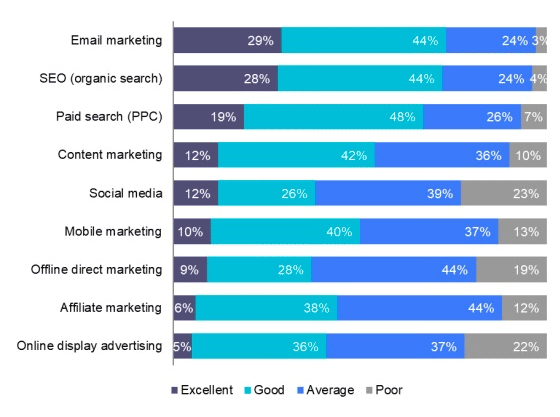
It’s not just about sending emails to everyone. You need to send the right message to the right person. For example, a shopper might add a product to their cart without checking out. You could send an email reminding them about the item and encourage them to come back and complete the purchase. To make the offer more appealing, you could add a time-limited discount.
Emails like this aren’t just about closing a sale. These personalized interactions can forge deeper connections with customers and turn occasional shoppers into loyal brand advocates.
It’s important not to overdo it. Don’t flood your customer’s inbox with promotional emails. They want to hear from you when you have something valuable to share.
6. Content marketing and SEO
Content marketing and SEO (search engine optimization) are crucial elements of every eCommerce strategy. When used together, they can drive organic traffic, enhance customer engagement, and boost sales.
Instead of shouting, “Buy this product,” you can use articles, guides, and videos to attract potential customers. The idea is to offer value and subtly promote your products.
Content marketing can have a significant impact on sales. According to a recent study, the average conversion rate for eCommerce sites that use content marketing is 2.9%, compared to only 0.5% for sites not using it.

But you need to do more than just write an article and click publish. Your content needs to be optimized for search engines. SEO is about understanding what people are searching for online and creating content that meets their needs.
According to a survey of SEOs by Databox, content is the most important element of an SEO-friendly website:

So, you need high-quality content to stand out. But you also need to focus on keywords and external links (backlinks).
Keyword research is the process of discovering the phrases people use to search for topics related to your products. You can use keyword research tools to determine which search terms your potential customers use. Then, you can include the keywords in your content, product descriptions, and titles.
Backlinks are links from other websites to your site. These links are a key Google ranking factor. The more high-authority websites that link to you, the more likely your store will rank high in search results.
You can use guest posting, broken link building, and creating awesome content that people want to share to attract more backlinks.
7. Influencer collaboration partnerships
Teaming up with influencers can be a great way to expand your reach. Influencers have an engaged following on social media. When they recommend something, their followers are likely to listen.
You can work with influencers on sponsored content campaigns to promote your products. It can be a highly effective strategy. In a recent survey, 80% of marketers stated they found influencer collaboration marketing effective:
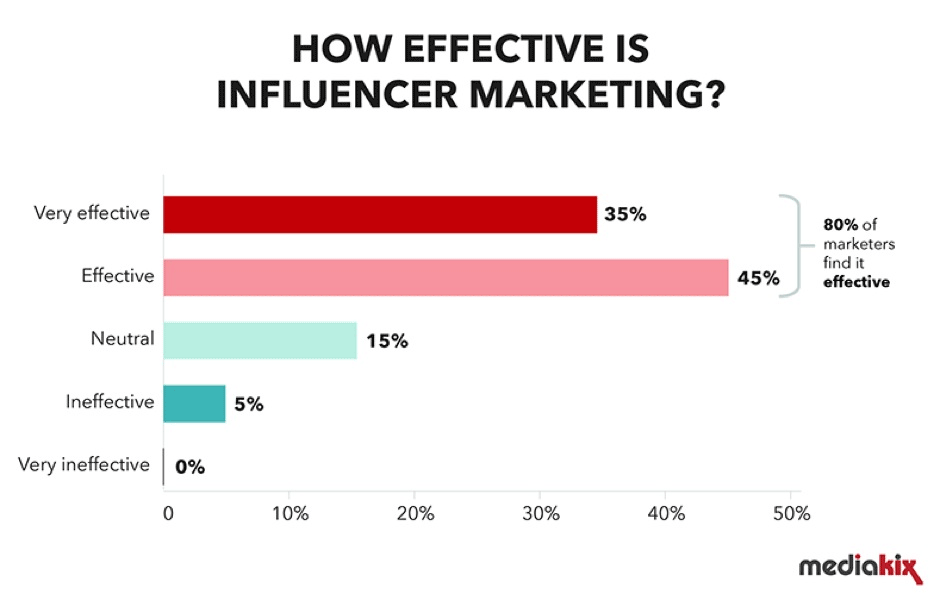
The key to successful influencer marketing content is prioritizing storytelling over hard selling. Audiences are more likely to engage with narrative-driven content than a straightforward product plug.
It’s also important to give the influencer some creative freedom. They know their audience best and how to engage them. You should set guidelines to make sure the promotion aligns with your brand, but don’t micromanage the creative process.
Influencer collaboration marketing isn’t the only way to promote your products online. Check out our list of the best eCommerce strategies to learn how you can boost awareness and increase sales.
8. Affiliate marketing
Affiliate marketing is a powerful way to boost indirect sales. You can partner with bloggers, review websites, and content creators to promote your products. These partners are given a unique affiliate link to track sales.
The affiliate gets a reward when someone buys a product using their link. It’s like a finder’s fee or commission for sales reps.
You can use affiliate marketing to expand your reach and get your products in front of new audiences. It can be very cost-effective. A recent study found that retail businesses earn an average of $12 for every dollar they spend on affiliate marketing.
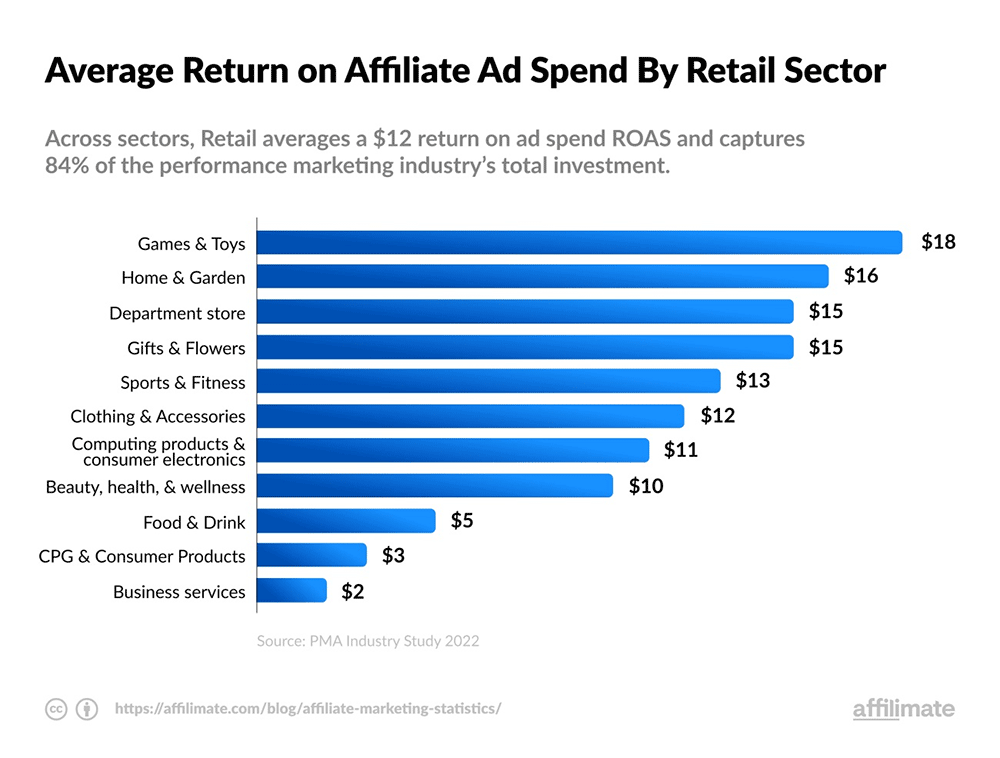
Finding the right affiliates is key. Not everyone will be a good fit for your affiliate sales team. Look for affiliates that have an existing audience who might be interested in your product.
You also need to give affiliates the tools they need to succeed. This could be high-quality images or exclusive discounts they can share with their audience. You can also provide free products for affiliates to test and review.
9. Subscription boxes
Subscription boxes are one of the fastest-growing sales channels for eCommerce. Shoppers get a regular delivery of curated products, often tailored to their personal preferences. It can be a good way to secure consistent revenue and sales.
While most people have a Netflix or Spotify subscription, shoppers have started to use subscription services for eCommerce products. A McKinsey study found that 15% of online shoppers have used an eCommerce subscription service in the past 12 months:

One of the standout features of the subscription box is product curation. You can create a unique value proposition by personalizing the box content based on the shoppers’ preferences. It’s also a great way to introduce your customers to new products.
Looking for lucrative products to flip? Discover the 15 best items to flip and sell for a profit in 2023.
Factors to consider
There are a lot of different types of sales channels that you can use. So, how do you know the best option for your eCommerce store?
Here’s a breakdown of things you should consider.
Target audience and demographics
Imagine you’re throwing a party. You wouldn’t invite your grandmother the same way you’d ask your best friend from college, right?
In the same way, you need to think about where your customers are and the best way to reach them.
If you sell trendy jewelry aimed at teenagers, you’ll probably have more luck on social media platforms like Instagram or TikTok. On the other hand, if you sell garden furniture, a platform like Amazon or eBay might work better.
Your products and industry
Some platforms and sales channels are more suitable for certain products than others. For example, people like to do lots of research before they purchase tech products. If you sell high-end headphones, you could set up an affiliate program and reach out to tech review sites. Customers use these sites to research headphones when making a purchasing decision.
Think about where customers who want your type of product might go. Then, make sure your products show up there.
If you want to sell wholesale rather than directly to consumers, you need to adjust your sales strategy and the places you sell online. Use the resources below to help you sell wholesale online.
Brand identity and messaging
It’s important to consider your brand identity when deciding where to sell products online. Where people find your products has a direct impact on customer perception.
For example, If you sell premium products, your target market expects a premium shopping experience. Luxury consumers aren’t just buying a product. They’re investing in an experience and a status symbol. Selling on budget platforms can dilute your brand and damage the customer experience.
Budget and resource allocation
You also need to consider how much money you have to spend. Some sales channels are free, while others have significant fees.
You’ll need to decide how much of the budget goes to each channel. If you spread your budget too thin, you might struggle to get results anywhere. But you could lose money if you put too much into one channel and it doesn’t work out.
Multichannel selling strategy
Here’s the thing. Selling in just one place isn’t enough. You need to sell on multiple sales channels to capture the attention of shoppers and get your products found.
According to a recent study by ClickZ, marketers that use three or more channels have a 250% higher engagement rate than those that use a single channel:
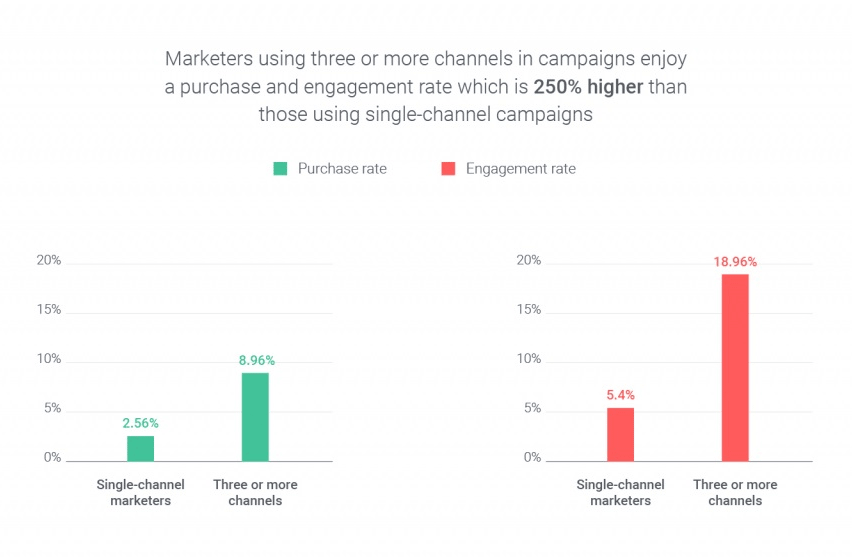
Sometimes, things can go wrong. Your website may have technical problems, or a third-party marketplace may change its rules. If you only sell in one place, issues like this can be a big problem.
That’s why diversification is so important.
If you sell in many places, one setback won’t stop your entire business. You’ll have other distribution channels to fall back on and keep sales rolling in.
Integrating multiple channels effectively
It’s not just about being present in many places. You need to make sure those channels work well together for a smooth sales process.
Imagine going to an online store and buying a product priced at $25. But later that day, you saw the same product was $20 on their Facebook shop. That would be confusing and annoying.
You need to keep everything consistent across all your channels. Customers should get the same customer experience wherever they find you. This is super important. But only just over half of eCommerce sites currently have omnichannel capabilities.
So, how can you integrate all your different sales channels?
Automation and management tools for multichannel selling
This is where automation and management tools come into play. These eCommerce tools help you keep everything organized and running smoothly.
You don’t have to manage every single sales channel separately. You can do it all from one place. If you want to change the price of a product, you can do it once, and the tool will update it everywhere.
3 eCommerce sales channel case studies
Everyone loves a good success story. In the following case studies, we’ll explore how three real brands have excelled on specific channels.
Case Study: Glossier on Instagram
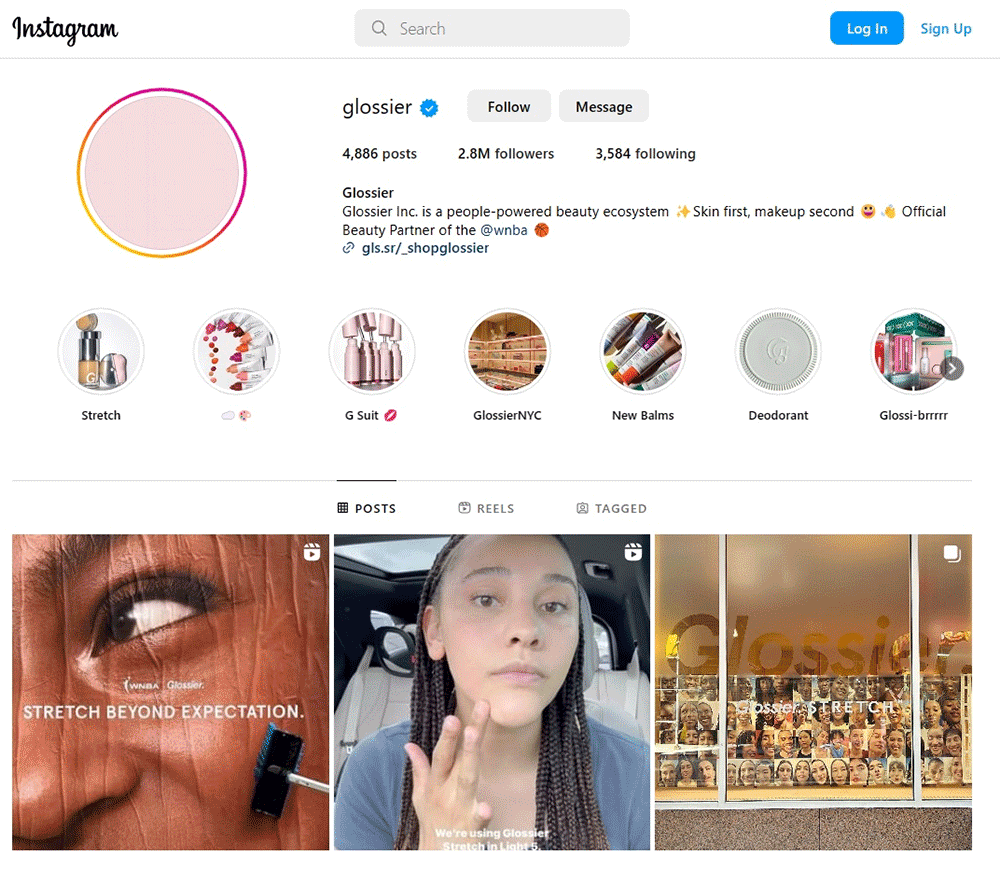
The beauty brand Glossier has harnessed the visual power of Instagram to showcase its products and drive eCommerce sales. Glossier has a community-driven approach, encouraging customers to share the makeup looks they have created using its products. This strategy turned the Glossier Instagram profile into an interactive beauty hub. It transformed followers into brand advocates and amplified their reach.
Lessons learned:
Glossier’s Instagram success shows that engaging your customers and making them part of your brand story can lead to strong loyalty. By featuring user-generated content, Glossier showcases its products. But it also fosters a sense of belonging within the community.
Case Study: Fanatics affiliate marketing
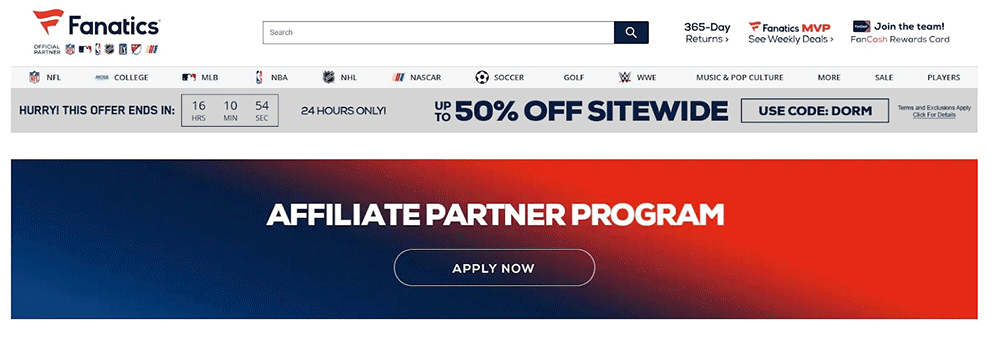
Fanatics has achieved huge success with affiliate marketing. It’s become a dominant player in the sports retail industry. The brand offers a wide variety of sports-related products, catering to fans of different teams.
Fanatics partnered with content creators, bloggers, and influencers to expand their reach. Affiliates receive promotional materials embedded with a unique tracking code.
Lessons learned:
This example highlights the potential of affiliate marketing strategies to enhance brand visibility and drive sales. It shows how lucrative it can be to partner with passionate content creators. Fanatics also provides affiliates with appealing creative assets to support their promotional efforts.
Case Study: Anker on Amazon

The consumer electronics brand Anker is an excellent example of how to thrive with a marketplace business model. They’ve achieved great results by selling products on Amazon’s online marketplace. High ratings and positive reviews established Anker as a trusted brand among Amazon customers.
Lessons learned:
Anker’s accomplishment on Amazon shows how brands can strategically position themselves on online marketplaces. They capitalized on the marketplace’s wide customer base and infrastructure while delivering quality and value.
Anker optimizes product listings with attractive visuals and informative content. It also leverages Amazon’s fulfillment services for fast shipping to boost customer satisfaction.
Grow your eCommerce business on multiple channels
Choosing the right sales strategy sets your eCommerce store up for success. Each channel is an opportunity to showcase your products and boost sales.
As the eCommerce landscape keeps changing, you’ll need to stay flexible and adapt your approach. The golden rule is to make sure you show up where your customers are.
To grow your eCommerce store, you need great products and reliable suppliers. The SaleHoo Directory is the best place to discover lucrative products and trusted suppliers you won’t find on Google.
And if dropshipping is more your thing, SaleHoo Dropship should be your go-to tool. You can find the best products on AliExpress and add them to your store in a few clicks. Our team of eCommerce experts find lucrative products to save you hours of research.
If you’re unsure which sales channels are right for you, our 24/7 customer service team is here to help.











